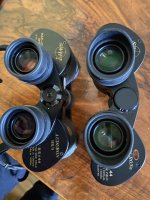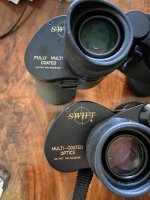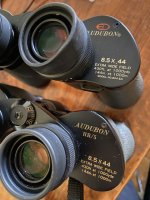Sorry to ruin the vibe here. But I recently made a very disappointing discovery. I found a 'as-new' HR5/fmc/ED ’93 804-model with the red rings around the objectives. It not only smelled new, but included the original cleaning cloth and neck strap still folded and unused.
I already owned a more common HR5 (MC) ’90 model which is also in very good condition (and a 10x50 Supreme + a Kestrel as well - fanboy?). To be honest, I enjoy to use the HR5 more than my Nikon 8x30 EII. So both HR5’s are on good condition, non-ED & ED, without haze etc. just a tiny few specks inside due to old age I guess. So I was eager to do a side-by-side.
The ED is indeed a tiny fraction higher when put straight with the objectives on the table. And it also has somewhat more weight.
But most importantly, looking through both, I immediately saw the ‘normal’ HR5 MC was brighter, 'fresher’, meaning: ED FMC seemed to be dimmer, and white surfaces in the ED are slightly more to the magenta, whereas the HR5 MC is slightly more to the yellow-greenish side. Hmm.
But the most shocking discovery moving between the two (both on a tripod on top of each other and pointing at the same object; a sunny city landscape with trees, darker houses with bright white window-frames at ±100m etc) was the fact that the ED had a softer image! meaning: less sharpness. Uh?
Also the ED’s sweet spot was narrower (and somewhat more shaped like a cat’s eye instead of round; something I’ve read here from another one with bad experience with the ED model 804). What a shock! At first I couldn’t believe it, as it was like new and perfectly collimated etc. So I checked again and again, tunneling light beams through it, looking for haze inside, or other imperfections, and checked sharpness again an again.
Of course I’ve read on this site some very problematic experiences with this ED model, so probably almost every(?!) Audubon is different no matter what it says on the outside?! Similar with the praised Kestrel, which is one of the last (10x50 Audubon Kestrel FMC - all written in blue letters) but strangely its edge sharpness declines faster than the older MC 8.5x44 in a direct side-by-side.
All in all severely disappointing. At first I even assumed the glorifying of the ED that I read here was being a big joke, after doing a side-by-side. But maybe I just have a perfect tuned ‘normal’ MC HR/5 that is just blowing away every competition. So despite people telling me to hold on to this valuable bino, I sold the ED again.
Sorry to say but this experience made me also angry of myself, spending endless nights reading the nerdy discussions about subjective quality experiences on the web. Not that I do not appreciate the input of the writers, on the contrary! And yes it could be true that the physicality of your eyes, their shape and their age, all must be taking into account as well. But at the end of the day, at the basis of these opinions and advices, we should have something honest to fall back on, don’t we?
Maybe this is a lesson for everybody that - unless you might be measuring things scientifically (like Allbino’s etc) - most of the writings here are way too subjective, at least to spent a lot of money on. Certainly when it comes to so called old and ‘legendary’ bino’s, even if they’re in immaculate state. Wow, lesson learned.
Ps besides the Audubon HR5 8.5x44, I also own a Swift Supreme10x50, Swift Audubon HR/5 FMC Kestrel 10x50, both Nikons EII’s (8x & 10x), Zeiss Terra 8x25, Hartmann 8x30 Compact (sold), Nikon 12x50 EX and a APM 100 semi-apo giant bino.










